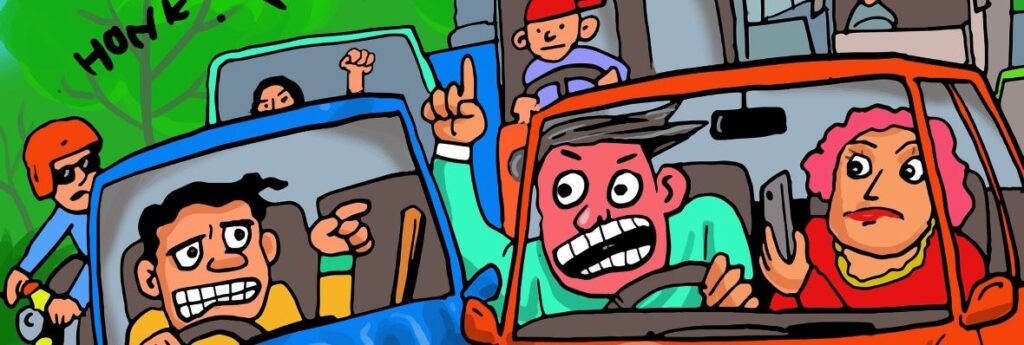Only Canadians could be polite road ragers. At least, that’s what we consider ourselves, according to a new survey that says that though 95 percent of Canadian drivers admit to aggressive driving behind the wheel, 94 percent of the same respondents consider themselves to be courteous drivers.
From speeding and tapping the car’s brakes when being tailgated to following too closely and weaving in and out of traffic, it seems Canadian drivers are not nearly as courteous – or as calm and rational – as they believe themselves to be. This is also true considering that drivers admit to honking in frustrated anger and flipping the occasional bird at other drivers.
“The way drivers perceive themselves to be courteous versus how they behave, even if only occasionally, is contradictory,” says Anne Marie Thomas, an insurance expert at InsuranceHotline.com in response to the Leger online poll of over 1,500 Canadians conducted in April. “You can’t be a courteous driver on one hand while on the other your behaviour is aggressive at best, or borders on road rage.”
Disturbingly, the survey found that nearly three-in-10 drivers have entertained the idea of taking it one step further by doing something impulsive, like throwing an object at another vehicle, physically confronting another driver, or trying to frighten someone by following them for a while. Other drivers, meanwhile, admit to acting on these same hotheaded impulses:
28% of drivers have been angry enough behind the wheel to think about doing something impulsive.
• Drivers under the age of 35 (38%) were more likely to admit to these thoughts than those 35 or older (25%).
• Men (35%) admit to these rash thoughts more than women (21%).
• 14% have been angry enough to do something impulsive.
Drivers under the age of 35 (21%) were more likely to say they’ve acted on their impulses versus those 35 or older (11%).
• Men (21%) admit to this reckless behaviour more than women (7%)
• Most road rage behaviour isn’t as extreme as acting on frustrations but can still take aggressive and dangerous forms.
Shockingly to anyone that drives the 401 for a living, and contrary to perceptions, Ontarians did not rate near the top of any category for aggressive driving or rude behaviour. And Albertans and Maritimers similarly come off well. (Or perhaps residents of these provinces are simply the most delusionary and won’t admit to it).
For example, the breakdown of angry antics admitted to by drivers (and those who admit to it most):
• Speeding (82%) – BC (88%)
• Purposely braking when someone follows too closely (63%) – Sask/Man (74%)
• Honking in angry frustration (60%) – Sask/Man (66%)
• Weaving in and out of traffic (58%) – Quebec (69%)
• Swearing and making hostile hand gestures (57%) – BC (70%)
• Tailgating a slow-moving vehicle (47%) – Quebec (57%)
“It is clear people can be provoked into driving dangerously given that the vast majority of respondents admit to some form of aggressive and road rage-like behaviour,” says Thomas. “Speeding, tapping one’s brake to ward off a tailgater, weaving in and out of traffic and following too closely are all unsafe manoeuvres that can lead to a collision putting everyone’s safety at risk.”
While there’s no ticket for road rage, there is for speeding, tailgating, and careless driving. For extreme cases, criminal charges are also possible.
“The financial cost of road rage-like behaviour can be considerable even for someone with an otherwise clean driving record,” explains Thomas. “An at-fault collision could increase your premiums 25%, while a minor ticket for speeding or tailgating could cost an added 10%. A ticket for careless driving, which is a serious offence, will likely land you in the high-risk category for three years, costing several thousand dollars extra a year in coverage.”
Tips
With the Victoria Day long weekend at hand and summer road trips on the horizon, CAA South Central Ontario (SCO) is reminding motorists to prioritize safety, particularly when sharing the road with cyclists, and offers the following important rules of the road:
• Pay attention. Avoid distractions like texting, adjusting your GPS or scrolling through your playlist.
• Yield to cyclists. Motorists should not be driving in a bike lane unless making a right turn. Watch for the approaching cyclists and never speed up and cut off a cyclist when making a right turn.
• Keep a safe distance. Drivers must keep at least a one-metre distance when passing a cyclist. If it is not possible, safely change lanes to pass. The penalty for not doing so is a $110 fine.
• Practice the Dutch Reach. Avoid “dooring” cyclists by doing the Dutch Reach. CAA launched a new Dutch Reach video for users to practice as more people are out on their bikes.
Meanwhile, Insurancehotline.com offers up its own golden rules for keeping cool behind the wheel:
• Give yourself plenty of time to get to where you want to go. Being late is stressful and can heighten your reaction to things that might not bother you otherwise.
• Know where you’re going and how you’re going to get there. Being lost or indecisive can lead to erratic driving.
• Treat other drivers the way you want to be treated. Signal your intentions to change lanes, drive the speed limit and don’t block the passing lane, cut people off or drive distracted.
• Remember, mistakes happen, and everyone makes them. Don’t let another person’s mistakes behind the wheel affect your mood or behaviour while driving.
• Don’t react to another driver’s aggression, it will only escalate matters; avoid eye contact, making rude hand gestures, and honking back.

